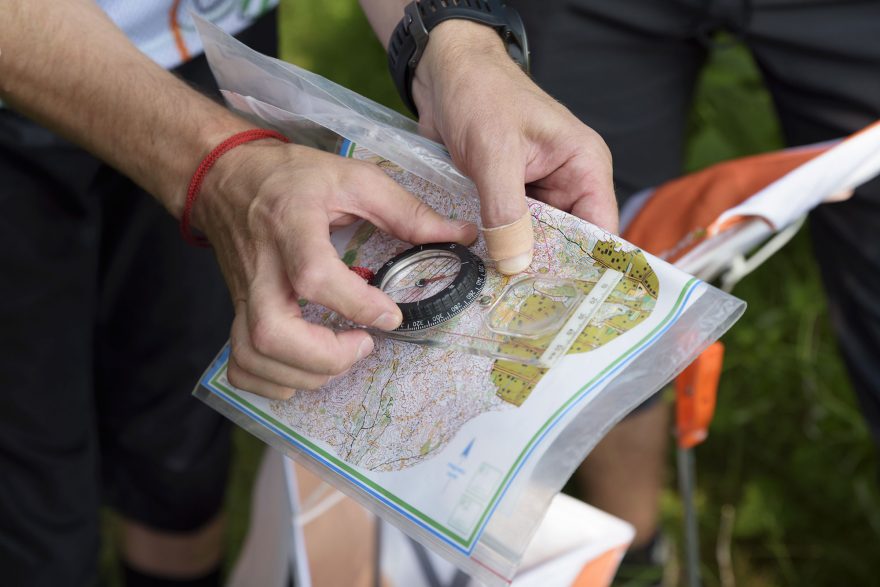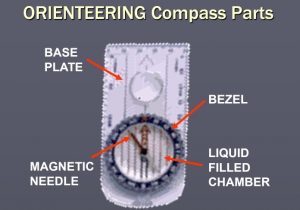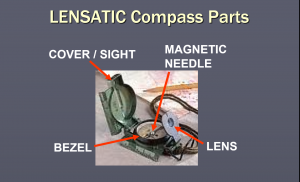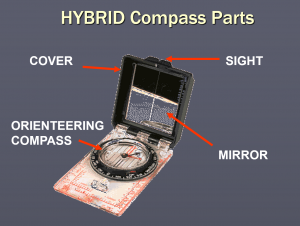
We all possess some sense of direction, but amid the valleys and trees and, sometimes, in rain or snowstorms, it’s easy to get turned around. You need something more substantial to help you stay on course. Rarely is anything more practical — and more basic — than a compass (along with the skills of how to use it!). So, I hope to use this opportunity to shed some light on this oldie, but goodie, technology.
While this tool is over a thousand years old, it is still a handy item to master to keep from getting lost. I’m going to break it down into six parts, to cover the following topics: (1) Compass Selection; (2) Using an Orienteering Compass; (3) Cell Compass Apps; (4) Declination; (5) Map Reading; (6) Map and Compass.
Part 1: Compass Selection
Types of Compasses
There are many types of compasses out there. With various styles to choose from, and an equally varied price range, knowing which compass is best for you can be difficult. This article will give some guidance on choosing one that may be helpful for your outing.
All compasses, regardless of style, work on the same principle. They all contain a piece of magnetized metal that aligns with the Earth’s magnetic field. The convenience of the compass aligning with the magnetic field is that it gives a fairly fixed direction from which to measure all other directions. These directions are called heading (if you are going that way), bearing (if you are looking that way) or azimuth (typically used in the military). These directions can be phrased as one or a combination of cardinal directions (North, East, West or South), or between 0 and 360 degrees. One degree is 1/360th of a full circle.
Glow in the Dark
One of the optional features in compass construction is glow-in-the-dark capability. This capability allows you to see important parts of the compass in the dark. Not all compasses have this feature, and most people do not need it. The compasses that can glow accomplish that either through phosphorescence or with tritium. The phosphorescent elements are charged by shining a light on the compass, allowing them to emit low-level light for 20 to 30 minutes. If the compass has tritium in it, then it will glow on its own for years. Tritium is a harmless (just do not eat it) low-level radioactive isotope of hydrogen. This is an expensive feature, so it adds a few dollars to the cost of the compass.
Here are some individual characteristics that may help you decide which type you would prefer:
ORIENTEERING
Orienteering compasses are the simplest forms of the compass types, but they still have a few moving parts that, before reading this article, might be considered intimidating. While most compasses have different bells and whistles on them, here are the commonalities among most orienteering compasses:

Base Plate
The base plate is usually a clear plastic plate with a few features. The most important feature on the base plate is the direction of travel arrow. This appears differently on different compasses. It may show as a red triangle or, as in the image above, a black line starting at the bezel and ending at the arrow.
Another feature is a scale, that may be in inches, metric or both. There may also be a representative fraction scale or two on the base plate. These scales express a distance in miles or kilometers on a particular scale map. For example, marks may show tenths of a mile for a 1:24,000 scale map. Be aware that these marks only work on the specified scale map and will not work on different scale maps.
Other features on the base plate may include a magnifying glass and/or small stencils for drawing on the map underneath the compass.
Bezel
Orienteering compasses have a bezel on top of the housing. This bezel is usually a black plastic collar with 0-360 degrees printed on it. Most orienteering compasses have marks every 2 degrees. This bezel can be turned and set according to practices that will be discussed in another article (declination).
Magnetic Needle
The most important part of the compass is the needle. It is magnetized and orients itself to the Earth’s magnetic north pole. It is usually colored two different colors (red & black or red & white) to indicate the north and south aspects of the needle. Usually the red section is the “north” half of the needle. This needle should be allowed to move freely to point toward magnetic north.
Housing
Orienteering compasses typically house the needle in a fluid-filled chamber. This fluid has a freezing point below zero. The fluid slows the needle movement and protects the needle from damage. On occasion this fluid can leak out. If a little fluid leaks out, a bubble may form in the housing. A bubble, if big enough (size of small green pea or BB or larger), can impede free movement of the needle. On occasion these bubbles can form from a significant increase in altitude and may go away when the compass is lowered to the original altitude. If the bubble does not dissipate or it affects the movement of the needle, it is time to replace the compass.
LENSATIC
This type of compass is called lensatic because of a lens you look through to read the azimuth on the disc in the middle of the housing. This style is typically used in military applications.

There is a collar on the top of the housing that “clicks” when rotated. Each click location is 3 degrees from the last one. This collar is attached to a glass covering, which also has a black line called an index line. This line can be used as a quick reference mark with which to align to the north arrow when setting a heading.
The compass is used by leaning the lens arm against the cover. You can then look through the sight notch on the lens arm through the cover to see objects in the distance, or you can look through the lens to read the azimuth on the dial. The dial has two sets of numbers printed on it. The set of numbers from 0-360 is degrees and is marked in increments of 5 degrees. The dial, like the needle in an orienteering compass, is moved by a magnetized strip of metal integrated into it.
HYBRID
Hybrid compasses combine characteristics of the orienteering and lensatic styles.

The hybrid compass is usually an orienteering compass with a hinged plate that contains a mirror on the inside as well as sighting features. This plate acts as a protective cover to the top half of the compass. The mirror can have multiple uses, including signaling and a specific use for the compass that will be explained in a future article. While the orienteering compass is perfectly good for navigating, the hybrid compass is the one I carry in my search and rescue pack for off-trail use.
REASONABLE COSTS
Cost is always a consideration when purchasing most any item. The cliché “you get what you pay for” applies to compasses as well. There are also products that cost more than I would recommend investing in this tool. Many of the good-quality name brands such as Suunto, Silva and Brunton are good about replacing their compasses if something goes wrong, such as a bubble forming in the housing.
In addition to the features described above, orienteering compasses on the market present a variety of bells and whistles. My recommendation is to spend $20 to $35 on a decent compass. While something is better than nothing, a few more dollars can add quality and characteristics that a cheap version does not provide. The same holds true for hybrid compasses, but my price window increases a little from $35 to $50.
Cammenga is one company that produces military-grade, high-quality lensatic compasses. The tritium versions retail for around $80 to $90, and the phosphorescent ones around $60. Items that retail that expensively have lots of cheap imitations made. While it is possible to find a look-alike model for $10 to $20, they will not be anywhere near the quality of craftmanship of the originals.
FINAL RECOMMENDATIONS
If you are looking for something to put in your pack for casual use, I recommend the orienteering-style compass. It is light, small and usually accurate to within two degrees. If you are looking for something to use often that is as accurate as can be, and you don’t mind paying a little more for it, I recommend the hybrid compass. If you are going into the military, I recommend getting familiar with the lensatic compass.
Rob Speiden is a professional search and rescue volunteer who has participated in over 330 searches since 1993. He teaches land navigation, tracking and other SAR classes for both the Virginia Department of Emergency Management and his own Natural Awareness Tracking School. Rob has written two books on tracking humans for SAR: “Foundations for Awareness, Signcutting and Tracking” and “Tracker Training.” More information about Rob’s books and classes can be found at www.trackingschool.com.
 Your Privacy Choices
Your Privacy Choices